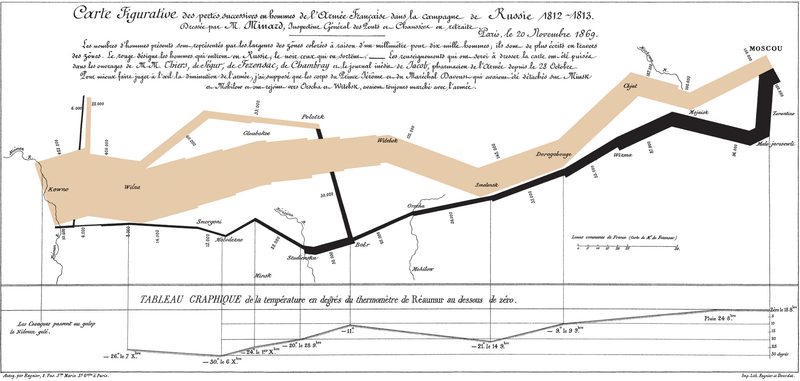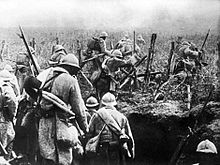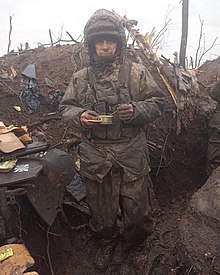|
Attrition warfare
Attrition warfare is a military strategy consisting of belligerent attempts to win a war by wearing down the enemy to the point of collapse through continuous losses in personnel, materiel and morale.[1] The word attrition comes from the Latin root atterere, meaning "to rub against", similar to the "grinding down" of the opponent's forces in attrition warfare.[2][3] Strategic considerationsAttrition warfare represents an attempt to grind down an opponent's ability to make war by destroying their military resources by any means including guerrilla warfare, people's war, scorched earth and all types of battles apart from a decisive battle.[4] Attrition warfare does not include Blitzkrieg or using concentration of force and a decisive battle to win. The side that reinforces their army at a higher speed will normally win the war. Clausewitz called it the exhaustion of the adversary.[5] A side that perceives itself to be at a marked disadvantage may deliberately seek out attrition warfare to neutralize its opponent's advantages over time. Sun Tzu has stated that there is no country that has benefitted from prolonged warfare,[6] but Russia in 1812 won the war with attrition warfare against Napoleon. When attritional methods have worn down the enemy sufficiently to make other methods feasible, attritional methods are often complemented or even abandoned by other strategies. World War I military commanders on both sides ineffectively relied on attrition warfare, which resulted in casualties without a strategic result. The difference between war of attrition and other forms of war is somewhat artificial since even a single battle normally contains an element of attrition. A strategy of attrition is an attempt to cause the enemy great losses in a single stroke (such as by encirclement and capture). Attrition warfare also tries to increase the friction in a war for the opponent.[7] While attrition warfare might appear to be a strategic option for combatants possessing greater resources or asymmetric advantages over their adversaries, it also carries considerable drawbacks. Perhaps the most common reason for failure of attrition warfare is related to the time required to fulfill one's war goals. The geopolitical and strategic situation may shift dramatically over long periods of time, potentially giving the opponent an edge if victory is not achieved soon enough. Additionally, the attrition strategies gives opponents time to adjust tactics and strategy.[8] Although the strategy is typically victorious for the more well-resourced nation, it may eventually fail due to operational and geopolitical mishaps, such as Athens during the Peloponnesian War, or due to strategic miscalculations, such as Germany during the Battle of Britain. Examples in historyMost typical The French invasion of Russia is a textbook example of attrition warfare, where Russia interfered with Napoleon's military logistics and won the war without a decisive battle. One of the best visual representations of the Russian attrition warfare strategies was created by Charles Joseph Minard. It shows the steady decrease of the number of soldiers of the French Grande Armée during the course of the war.  Minard's map of French casualties, see also Attrition warfare against Napoleon
Best known One commonly known example of attrition warfare might be on the Western Front during World War I.[9] Both military forces found themselves in static defensive positions in trenches running from Switzerland to the English Channel. For years, without any opportunity for maneuvers, the only way the commanders thought that they could defeat the enemy was to repeatedly attack head on and grind the other down.[citation needed] One of the most enduring examples of attrition warfare on the Western Front is the Battle of Verdun, which took place throughout most of 1916. Erich von Falkenhayn later claimed that his tactics at Verdun were designed not to take the city but rather to destroy the French Army in its defense. Falkenhayn is described as wanting to "bleed France white"[10] and thus the attrition tactics were employed in the battle. Soldiers on the Italian Front fought a series of battles of attrition along the Isonzo River between June 1915 and November 1917.[11]  Attritional warfare in World War I has been shown by historians such as Hew Strachan to have been used as a post hoc ergo propter hoc excuse for failed offensives. Contemporary sources disagree with Strachan's view on this. While the Christmas Memorandum is a post-war invention, the strategy of attritional warfare was the original strategy for the battle.[13] List of wars
See also
Military theory
Notes
References
|

